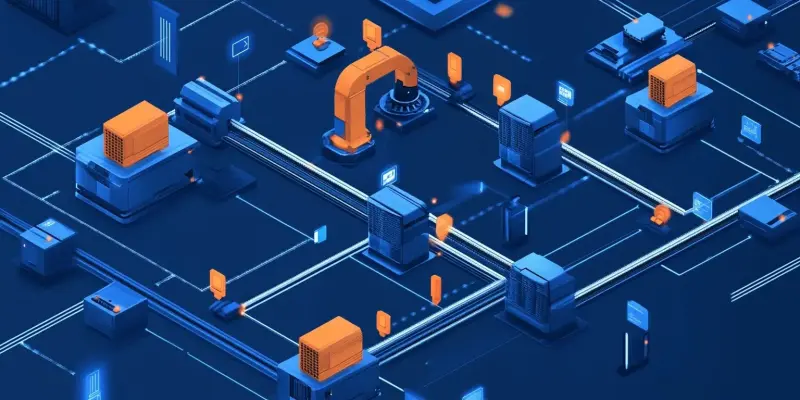Workflow automation engines are revolutionizing the way businesses operate by integrating advanced technologies to streamline processes, enhance efficiency, and foster innovation. This transformation leverages artificial intelligence (AI), cloud-native technologies, low-code platforms, hyperautomation, real-time monitoring, and blockchain to provide a competitive edge and drive operational excellence across various industries. These systems have become pivotal in reducing manual intervention, predicting potential bottlenecks, and enabling more informed decision-making. By leveraging these cutting-edge technologies, businesses are experiencing significant improvements in efficiency, accuracy, and overall operational success.
The Power of AI in Workflow Automation
Artificial intelligence plays a pivotal role in modern workflow automation engines. AI-powered systems utilize machine learning algorithms to predict potential bottlenecks and enhance decision-making accuracy, significantly reducing the need for manual intervention. Natural Language Processing (NLP) capabilities allow users to create workflows using conversational commands, which drastically reduce implementation time from weeks to days. These AI-driven engines not only improve efficiency but also ensure operational accuracy across diverse business processes.
AI’s predictive capabilities enable businesses to anticipate and mitigate issues before they escalate, ensuring smoother operations. By analyzing historical data and identifying patterns, AI can suggest optimal workflow adjustments, leading to more informed and timely decisions. This proactive approach minimizes disruptions and enhances overall productivity. Moreover, AI-driven automation engines can handle complex tasks that traditionally required human intervention. From data analysis to customer service, these systems can manage a wide range of functions, freeing up employees to focus on more strategic activities. This shift not only boosts efficiency but also fosters innovation by allowing teams to dedicate more time to creative problem-solving and strategic planning.
Cloud-Native Technologies: Enhancing Scalability and Resilience
Cloud-native technologies are integral to the scalability and resilience of workflow automation engines. By incorporating features such as containerization and serverless computing, these systems enable organizations to process millions of workflow instances daily while maintaining consistent performance. The resulting 99.99% system availability ensures business continuity even during high-demand periods. Event-driven architectures further optimize workflows by reducing latency and improving resource utilization. This allows companies to respond promptly to dynamic operational requirements, ensuring that processes remain efficient and effective. The flexibility offered by cloud-native technologies also facilitates seamless integration with existing infrastructures, enabling smoother transitions and optimized resource utilization.
Additionally, cloud-native workflow automation engines provide enhanced security and compliance features. With data encryption, access controls, and regular security updates, businesses can safeguard sensitive information and maintain regulatory compliance. This robust security framework is crucial for industries handling large volumes of confidential data, such as finance and healthcare. Furthermore, cloud-native technologies allow for real-time scaling of resources, ensuring that businesses can adapt to changing demands without compromising on performance. This scalability is essential for organizations experiencing rapid growth or unexpected spikes in workload, as it enables them to maintain efficiency and reliability in their operations.
Democratizing Workflow Design with Low-Code Platforms
Low-code and no-code platforms are democratizing workflow design by enabling business users with varying technical expertise to create and deploy workflows using visual tools. This accessibility reduces development time by up to 75% and accelerates digital transformation initiatives within organizations. Companies implementing these platforms report significant improvements in agility, allowing for rapid prototyping and streamlined deployment of automated processes.
These platforms empower non-technical users to take an active role in workflow design, fostering a culture of innovation and collaboration. By reducing reliance on IT departments, businesses can quickly adapt to changing market conditions and customer demands. This agility is particularly valuable in fast-paced industries where timely responses are critical to maintaining a competitive edge. Furthermore, low-code platforms facilitate continuous improvement by enabling users to easily modify and optimize workflows. As business needs evolve, workflows can be adjusted without extensive coding or development efforts. This iterative approach ensures that processes remain aligned with organizational goals and can adapt to new challenges and opportunities.
Hyperautomation: The Next Frontier in Workflow Innovation
Hyperautomation represents the next frontier in workflow innovation, combining robotic process automation (RPA), AI, and advanced analytics for comprehensive process optimization. Hyperautomation not only identifies automation opportunities but also continuously optimizes existing processes through learning and adaptation. Early adopters of hyperautomation have recorded up to 30% cost reductions while enhancing process accuracy and reducing redundancies.
By integrating multiple automation technologies, hyperautomation creates a cohesive and efficient operational framework. RPA handles repetitive tasks, AI provides intelligent decision-making, and advanced analytics offer insights for continuous improvement. This holistic approach ensures that all aspects of a process are optimized, leading to significant efficiency gains and cost savings. Hyperautomation also enhances scalability by enabling businesses to automate complex, end-to-end processes. As organizations grow and their operations become more intricate, hyperautomation ensures that workflows remain efficient and effective. This scalability is essential for companies looking to expand their operations without compromising on quality or performance.
Real-Time Monitoring and Adaptive Load Balancing
Workflow automation engines are transforming business operations by incorporating advanced technologies to streamline processes, boost efficiency, and drive innovation. This evolution utilizes artificial intelligence (AI), cloud-native solutions, low-code platforms, hyperautomation, real-time monitoring, and blockchain. These combined technologies provide a competitive advantage and foster operational excellence across various sectors.
Workflow automation systems play a crucial role in minimizing manual labor, forecasting potential issues, and enabling more informed decision-making. Businesses implementing these technologies are witnessing substantial improvements in efficiency, precision, and overall operational success. By automating repetitive tasks, companies can allow employees to focus on more strategic activities, driving business growth and fostering a culture of continuous improvement.
Furthermore, the integration of real-time monitoring and AI allows for proactive management and the swift resolution of issues, enhancing overall productivity. This blend of technology not only refines processes but also lays a strong foundation for sustained progress and adaptability in an ever-evolving market landscape.

